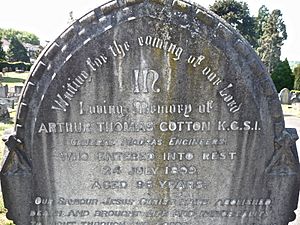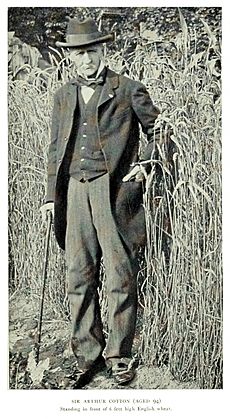Arthur Cotton facts for kids
Quick facts for kids
Sir Arthur Cotton
|
|
|---|---|
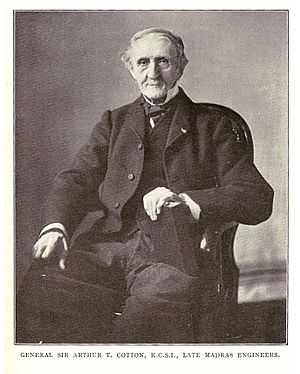
Sir Arthur Cotton
|
|
| Born | 15 May 1803 Combermere, Cheshire, England |
| Died | 24 July 1899 (aged 96) Dorking, Surrey, England |
| Allegiance | |
| Service/ |
Madras Army British Army |
| Rank | General |
| Battles/wars | First Anglo-Burmese War |
Sir Arthur Thomas Cotton (born May 15, 1803 – died July 24, 1899) was a British general and a brilliant engineer. He spent his life building important water systems in British India, which is now mostly India.
Cotton focused on creating canals for irrigation and navigation. These canals helped bring water to farms and allowed boats to travel easily. He built big projects like the Dowleswaram Barrage near Rajahmundry, the Prakasam Barrage, and the Kurnool Cuddappah Canal. These projects helped many people by making farming possible in dry areas.
Even though he didn't finish all his plans, people in Andhra Pradesh and parts of Tamil Nadu still remember and honor him. There's even a museum in Rajamahendravaram, Andhra Pradesh, named after him. It shows pictures and tools he used when building the Dowleswaram Barrage between 1847 and 1852.
Cotton joined the Madras Engineers in 1819. He also fought in the First Anglo-Burmese War. He was given the title of "Sir" in 1861 for his important work.
Biography
Arthur Cotton was born on May 15, 1803, at Combermere Abbey in England. He was one of eleven brothers. When he was 15, in 1818, he joined a military school called Addiscombe Military Seminary. He finished his training in 1819 and became a Second Lieutenant in the Madras Engineer Group.
He started his career in North Wales, where his reports were highly praised. In 1821, he moved to India. He first worked with the Chief Engineer in Madras. Later, he became an Assistant Engineer in the Tank Department, which managed water tanks.
Cotton also surveyed the sea passage between India and Ceylon (now Sri Lanka). In 1828, he became a captain. He was then put in charge of studying the Cauveri water system. He worked to clear soil from the ancient Kallanai Dam. Using its design, he built the Upper Dam in Kaveri near Tiruchirapalli. He also built the Lower Anaicut Dam in Anaikarai. These projects were very successful. They led to even bigger projects on the Godavari and Krishna Rivers.
Cotton learned a lot about building strong foundations in sandy areas from studying the Kallanai Dam. In 1844, he suggested building an "anicut" (a type of dam for irrigation) and planned for the Visakhapatnam port. Work on the Godavari anicut started in 1847.
In 1848, he went to Australia because he was not well. He returned to India in 1850 and became a colonel. He successfully finished the huge project on the Godavari River at Rajahmundry in 1852. After that, Cotton focused on building an aqueduct on the Krishna River. This project was approved in 1851 and finished by 1855. He then thought about storing water from both the Krishna and Godavari rivers.
In 1858, Cotton proposed even bigger ideas. He wanted to connect all the major rivers in India. He also suggested ways to help areas like Odisha during droughts. Arthur Cotton retired in 1860 and left India. He was knighted in 1861. He visited India again in 1862 and 1863 to give advice on river projects.
His work in India was greatly admired. In 1877, he received a high honor called KCSI (Knight Commander of the Order of the Star of India). He is highly respected in Andhra Pradesh for bringing water to the area known as Konaseema, making it very fertile.
Cotton passed away on July 24, 1899.
Impact of his work
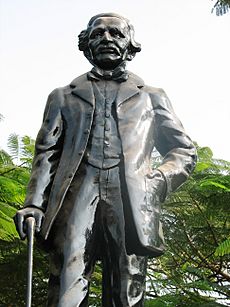
Arthur Cotton was sometimes disliked by his bosses. This was because he cared deeply about the people of India. He often put their needs first, even if it meant disagreeing with his superiors. At one point, some officials even tried to have him removed from his job.
Cotton saw how people in the Godavari districts suffered from famines and floods. This made him determined to use the Godavari River's water to help the community.
John Henry Morris wrote about Cotton's work on the Godavari:
The Godavari anicut is a truly amazing engineering feat in British India. It's a giant wall built across the river to stop its water from flowing uselessly into the sea. Instead, it spreads the water over the land on both sides. This helps water farms that used to depend on rain or small amounts of river water. Large areas of dry, empty land became fertile with many streams and channels.
In 1878, Cotton had to explain his plan for the Godavari anicut to a committee in the British House of Commons. He wrote a letter to the government, saying, "My Lord, one day's flow in the Godavari river during high floods is equal to one whole year's flow in the Thames of London." He was frustrated that the British government was slow to approve his important project.
Gautam Pingle, an Indian policymaker, noted that Cotton first thought of connecting all major rivers in India over 120 years ago. This idea, called a "national water grid," is still discussed by the Indian government today.
Legacy in India
To honor Cotton's work, a new dam built on the Godavari River was named after him. The Prime Minister of India, Indira Gandhi, opened it in 1982. People in the Godavari District call him the "Delta Architect" because his irrigation work made the area a "rice bowl" of Andhra Pradesh.
During the Godavari Maha Pushkaram festival in 2015, people paid respects to Arthur Cotton. A local politician, Nimmala Rama Naidu, even performed traditional Hindu rites for him.
A statue of Arthur Cotton stands on Tank Bund Road in Hyderabad, alongside statues of other important figures.
Major works as an engineer
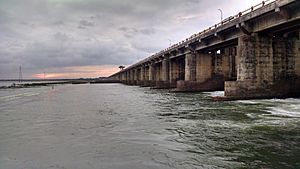
- The Godavari Canal System
- The Ganges Canal
- Sir Arthur Cotton Barrage
See Also
- List of dams and reservoirs in India
- Charles Phillip Brown, another westerner who is respected by Telugu people, an administrator and patron of Telugu
- Sir Sydney John Cotton (1792–1874), elder brother
- Rev. Richard Lynch Cotton (1794–1880), elder brother
- Dr. K.L. Rao
- Dr. K. Sriramakrishnaiah


